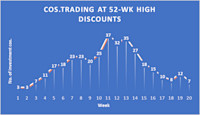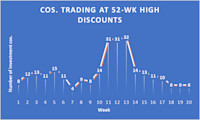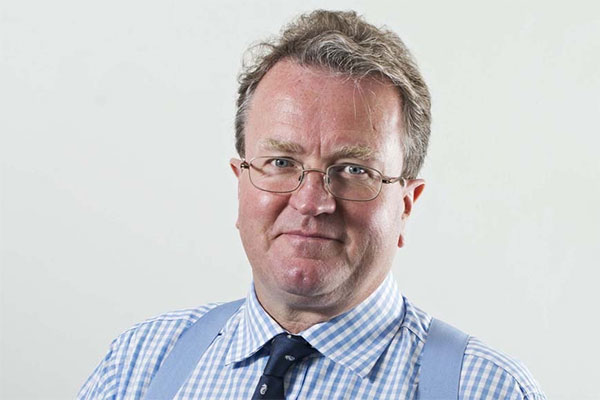The Results Round-Up – The Week’s Investment Trust Results
Which fund’s investment managers are sticking with their conservative approach as they think markets may take a hit? And which fund has generated a NAV per share total return of +381.9% over the last 10 years?
By
Frank Buhagiar
Schroder Asia Pacific (SDP) goes bargain hunting
SDP beat the benchmark over the half year – with a +5.7% NAV per share total return compared to the benchmark’s +5.3%. Chairman, James Williams, puts the outperformance down to stock selection and a significant underweighting to China. According to the investment managers, Chinese stocks had a miserable year – avoiding the laggards just as important as picking the winners.
SPD see reasons for thinking China can have a better year. Chief among these, ‘consensus expectations are now very low and this is reflected in lower valuations than a year ago.’ The managers are on the lookout for high-quality names they can pick up the cheap.
Numis: ‘The fund has an impressive long-term track record, with NAV returns of 9.8% pa over the past decade compared with 7.8% pa for the MSCI AC Asia ex Japan.’
Caledonia’s (CLDN) in control
CLDN’s three investment pools all contributed to the fund’s +7.4% full-year NAV total return: Public Companies (+12%); Private Capital (+12.3%); Funds (+2.2%). The fund has a long-term approach and CEO, Mat Masters, believes the global investor’s diversified portfolio and strong balance sheet can keep on delivering despite the uncertain external environment. Masters has got the team ‘focused on what we can control.’
Winterflood: ‘NAV TR +7.4% vs CPIH +3.8% and FTSE All Share TR +8.4%. Return was therefore within long-term target of inflation +3%-6%.’
Numis: ‘Caledonia has a strong long-term track record, delivering NAV total returns of 164% (10.1% pa) over the last ten years compared with 83% (6.2% pa) for the FTSE All Share Index and 228% (12.6% pa) for the MSCI World Index.’
JPMorgan “We think Caledonia remains an attractive proposition for investors seeking long-term real investment returns and a diversified portfolio.”
Investec: ‘The onset of the pandemic ignited a sharp de-rating. We would regard a fair value discount level, in normal market conditions, to be around the 20% level. We initiate with a Buy recommendation.’
HICL Infrastructure (HICL) sends a message
HICL’s full-year results included, as you’d expect, a flurry of numbers but perhaps ‘New dividend guidance of 8.35pps for FY 2026 and reaffirmed guidance of 8.25pps for the year to 31 March 20251’ best sums up the message. The £509m raised during the year via asset divestments at a weighted average 11% premium to carrying value also sends a message: the sale proceeds paid off the Revolving Credit Facility and funded a £50m share buyback programme. The sales added c. 2.5p to NAV per share although overall this came in 6.7p lower at 158.2p due to an increase in the weighted average discount rate to 8.0%.
Chairman, Mike Bane, believes HICL’s diversified portfolio, which includes over 100 high-quality, inflation-linked assets, offers shareholders attractive risk-adjusted value today and exposure to powerful infrastructure megatrends for tomorrow. A case of jam today and tomorrow.
Investec: ‘The portfolio continues to perform well operationally, and we reiterate our Buy recommendation.’
Numis: ‘We continue to view the rating as undemanding.’
Liberum: ‘Overall, we remain BUYers of the fund with a target price of 160p.’
JPMorgan: ‘We are Overweight HICL which is a constituent of our model portfolio.’
STS Global Income & Growth (STS) sticking to its guns
STS’ total assets increased c. 50% during the full year – the acquisition of former stablemate Troy Income & Growth Trust added £118 million so that by year end, total net assets stood at £314.4 million. Full-year share price/NAV total return came in at +6.1%/+4.8% respectively compared to the benchmark’s +11.5%. The Managers did not buy into the economic recovery narrative that buoyed global markets. ‘Investors anticipated an economic recovery – about which we are sceptical – leading the best performing sectors to be more cyclical areas such as extractive industries, banks and industrial companies.’ The managers’ quality focussed, conservative approach may have lagged the market but they continue to believe market exuberance may take a hit if the economy slows.
Numis: ‘The portfolio is managed using Troy’s distinctive style, with a focus on quality companies that generate high returns on capital through sustainable competitive advantages. As a result, it is heavily focused on defensive sectors, including Consumer Staples which have trailed behind other areas of the market in recent years.’
Scottish Mortgage’s (SMT) managers are excited
SMT Chair, Justin Dowley, described the fund’s latest full year as challenging yet rewarding. Dowley said, ‘the macroeconomic and geopolitical factors driving market anxiety are too numerous to mention’. The portfolio’s holdings of ‘resilient companies that possess the potential to shape the future of the modern economy’ have continued to ‘deliver strong operational performance and remain in robust financial health.’ After a two-year hiatus, share price and NAV returns were positive –share price up +32.5% (discount narrowed from -19.6% to -4.5% courtesy of that £1bn buyback programme); NAV up +11.5%. The FTSE All-World Index fell between the two – up +21%.
10-year track record still stacks up. NAV per share up +381.9% compared to +218.2% for the FTSE All-World index (total return). Portfolio Manager, Tom Slater, is ‘confident there’s more to come’ thanks to long-running themes such as artificial intelligence, digitalisation, scientific and engineering progress and the energy transition.
Jefferies: ‘The results provide the financial backdrop for the recent share buyback programme, highlighting both lower gearing and lower private asset exposure that offer the headroom to make very extensive use of buybacks in support of once again trading close to NAV.’
Numis: ‘The shares closed last night on a c.10% discount and we believe this offers significant value.’
Schroder Oriental Income’s (SOI) stock pickers get it right again
SOI outperformed over the half-year period – NAV per share up +7.5, while the MSCI AC Pacific ex Japan Index was up +1.9%. Over three years, NAV total return has now outperformed the index by +23.6% and since inception in 2005 the fund has generated total returns of +489.0% compared to the index’s +288.5%. The secret of SOI’s success? The Investment Manager’s focus on identifying quality companies. As Chairman, Paul Meader, explains, ‘Fundamentally, we are stock pickers and do not seek to predict macro-economic trends or geopolitics.’
Numis: ‘The fund benefits from an experienced fund manager, Richard Sennitt, who has run open-ended Asian Income mandates at Schroders for over 20 years, having joined in 1993. Schroder Oriental Income pays a dividend yield of c.4.5% and dividend growth has been strong since inception.’
Shires Income (SHRS) waiting for interest rates to fall
SHRS’ full-year NAV and share price total returns moved in opposite directions – NAV per share up +5.1, share price down -5.7%. The benchmark beat them both, returning +8.4%. Chairman, Robert Talbut, is not surprised, ‘the performance for the year is in line with what we would expect, given the defensive and income focused nature of the portfolio’. On the corporate front, it was a busy year. Combining with abrdn Smaller Companies Income increased SHRS’ size by more than a third. That’s one way to grow.
Looking ahead, the investment managers believe as interest rates fall this will increase the relative appeal of the proposition. The managers explain that investors can currently earn a decent risk-free return from cash but, as rates come down, they believe SHRS’ 6.5% dividend yield will become more appealing again.
Winterflood: ‘At 31 March, 80% of portfolio was invested in equities and 20% in preference shares.’
Capital Gearing Trust (CGT) goes seismic
CGT’s +1.8% full-year NAV total return was described by Chair, Jean Matterson, as far from satisfactory – the flexible investor failed to match the Consumer Price Index’s +3.2% rise. Rising interest rates, widening investment trust discounts and a strong sterling all held back performance. However, all is not lost. With nearly 70% of the portfolio invested in high-quality bonds, the major reset seen in fixed income markets has been a headwind these past two years. But with the fund’s bonds now ‘yielding well in excess of inflation’, future returns should be well underpinned from here on.
Matterson ends her statement with a little seismology, ‘As the tectonic plates of macro-economic fragility and technological change grind against one another, no one can tell when or where the next earthquake will occur. This Company exists to protect its shareholders from just these sort of disruptions.’
Numis: ‘Capital Gearing’s results show a period of muted returns, which is largely unsurprising given the fund’s defensive positioning. The managers point to the exceptional value in investment trusts where exposure has been increased. We agree. The average sector discount remains close to post GFC lows, with many alternative asset ICs in particular offering exceptional value.’ Well said.












